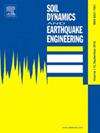对延性受限的钢筋混凝土框架抗震行为的实验和数值研究
IF 4.2
2区 工程技术
Q1 ENGINEERING, GEOLOGICAL
引用次数: 0
摘要
近几十年来,特殊延性的概念已被普遍用于设计钢筋混凝土框架以抵抗强震。在许多情况下,强震对延性的要求受到限制,例如受重力荷载或风荷载而非地震荷载作用的结构,以及具有几何特性的框架,其尺寸无法在梁端形成塑性铰。为评估此类结构的性能,本研究将重点放在具有符合规范细节的中间钢筋混凝土框架上。在 9 个从 0.10 g 到 0.60 g 的递增激励记录序列下,对一个 3 层的中间框架进行了振动台试验,这些记录代表了从轻微到严重的地面运动。观察到了相对令人满意的性能:最大层间漂移比不超过 1.57%,裂缝不是集中在构件的端部,而是沿着梁和柱的跨度分布,连接处几乎没有裂缝。为了研究不同参数的影响,开发了一个数值模型,并根据测试结果进行了验证。模型考虑了三个基本参数:地震事件剖面、梁的跨深比和连接长宽比。结果表明,不同因素的影响从大到小依次为:地震事件剖面、梁柱连接处的长宽比、梁的跨深比。数值分析表明,在远场激励下和连接长宽比大于 0.9 时,框架不会超过生命安全限值,但在近断层地震下,框架可能会达到防倒塌限值。总之,该研究对延性受限的钢筋混凝土框架的地震响应提供了一些启示,并对其在高地震区的可行性和局限性提供了一些指示。本文章由计算机程序翻译,如有差异,请以英文原文为准。
Experimental and numerical investigation of the seismic behavior of reinforced concrete frames with restricted ductility
In recent decades, the concept of special ductility has been commonly used to design reinforced concrete frames to resist strong earthquakes. There are numerous situations where strong earthquakes impose restricted ductility demands, e.g., structures governed by gravity loads or wind loads rather than seismic loads, and frames with geometric properties such that the dimensions prevent formation of plastic hinges at the ends of beams. To evaluate performance of such structures, this study has been conducted and emphasis is placed on intermediate reinforced concrete frames with code-conforming details. Shake table tests are conducted on a 3-story intermediate frame under a sequence of 9 incremental excitation records varying from 0.10 g to 0.60 g, representing minor to severe ground motions. A relatively satisfactory performance is observed: the maximum interstory drift ratio does not exceed 1.57 %, cracks are not localized at the ends of members but distributed along the spans of both beams and columns, and joints remain almost uncracked. To examine the effects of different parameters, a numerical model is developed and verified against the test results. Three essential parameters are considered: seismic event profile, span-to-depth ratio of the beam, and joint aspect ratio. The results show that the effects of different factors may be ranked from highest to lowest as follows: seismic event profile, aspect ratio of the beam-column joint, and span-to-depth ratio of the beam. The numerical analyses show that the frame will not exceed life safety limit under far field excitations and for joint aspect ratios larger than 0.9, but it may reach the threshold of collapse prevention limit under near fault earthquakes. Overall, the study sheds some light on seismic response of RC frames with restricted ductility and provides some indications of their feasibility as well as their limits in high seismic zones.
求助全文
通过发布文献求助,成功后即可免费获取论文全文。
去求助
来源期刊

Soil Dynamics and Earthquake Engineering
工程技术-地球科学综合
CiteScore
7.50
自引率
15.00%
发文量
446
审稿时长
8 months
期刊介绍:
The journal aims to encourage and enhance the role of mechanics and other disciplines as they relate to earthquake engineering by providing opportunities for the publication of the work of applied mathematicians, engineers and other applied scientists involved in solving problems closely related to the field of earthquake engineering and geotechnical earthquake engineering.
Emphasis is placed on new concepts and techniques, but case histories will also be published if they enhance the presentation and understanding of new technical concepts.
 求助内容:
求助内容: 应助结果提醒方式:
应助结果提醒方式:


